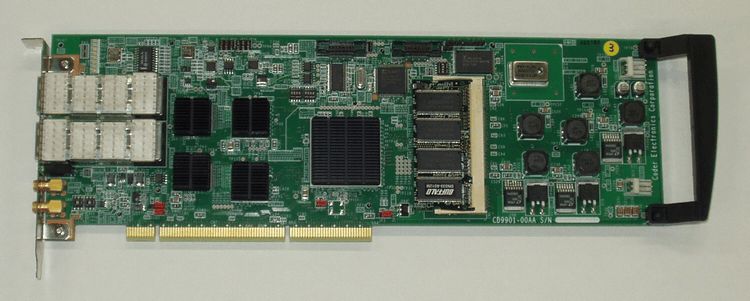Research
Labo(Internet Time-Transfer Technique)
■Experiment equipments
■NTP Experimental Servers using FPGA
Upper: A SNTP
server using our PCI-X hardware server card which was developed in 2004.
This
server uses the clock signal directly from the Japan standarad time which is
maintained in NICT.
Middle: The same hardware as above.
This PC
is used for measuring other NTP/SNTP servers using our FPGA hardware
card.
The Japan standarad time is also supplied to this
server.
Lower: 10GbE and GbE L2/L3 switches.
10Gbase-LR port
on the left side is connected to the NICT Otemachi via the WDM line.
■SNTP servers using smaller server cards.
Upper: Ordinary
software NTP server using ntpd version 4.
Middle: A SNTP server
using smaller server card which was developed in 2005.
Lower: The
same hardware as above. This is for cold stand-by.
■Hardware of Time Stamper and hardware of SNTP server

In order:
Machine for 10GbE(development in
2004)
Machine for GbE(development in 2004)
Small size machine for
GbE(development in 2005)
All of these three kinds of cards operate as
pass-type Time-stamper (original packet format).
The delay time between each
main base can be independently measured by one packet by inserting it in the
main base on the network.
There is the memory of 1GB on two
upper kind of large-scale card. It is possible to capture packet header at the
wire speed and to send an arbitrary Ethernet frame at accurate intervals of
time.
There is on two lower kinds of cards the SNTP server and the
miscellaneous function (for composing a precise NTP client).
Though thinks
that installing these functions in the machine for 10GbE of is possible, but not
carry into effect yet.
The small size machine for GbE was miniaturized.
(Some functions were omitted from a large-scale card developed in 2004 and the
mounting density was raised upper by reexamining parts and the substrate
composition.)
At the same time, a detailed point (like the part relations to
convenience on the programming, and the Falesafe function when the SNTP server
is really operated)
is improved. Installed OCXO (crystal oscillator with the
temperature controlled bath) is stably though small, and the frequency
fine-tuning by the register value rewriting became possible.
■Machine parts related to supply of signal of time
In
order:
Notebook computer for data collection
Counter of time
interval(2)
10MHz signal: Distribute machine of five outputs
1PPS signal:
Distribution machine of five outputs
Rubidium clock for comparison
1PPS
signal: Distribution machine of ten outputs
10MHz signal: Distribution
machine of ten outputs
The signal is received in the Japan Standard Time
Group at NICT of the maintenance at a Japanese standard with machine parts here,
and it distributes it to the experiment machine parts of our
group.
■Feedback control algorithm performance evaluation experiment to rubidium clock
Upper row: Rubidium Clock made in Stanford Research
Company
The lower: Cesium Clock made in Agerent Company
In
the device here, the difference of time with the cesium clock is measured, and
the performance evaluation experiment of the algorithm that feeds back the
result to the rubidium clock is done.
If the machine parts developed in our
group is used, the difference measurement of time in the error margin of the
micro seconds or less becomes possible by way of the high-speed Internet line.
This develops the control algorithm for that at the level that can be used
enough for the rubidium clock in the remote place to synchronize.
■GPS common view device
Though a usual GPS receiver
receives information on the position and time from the GPS satellite, The GPS
Common View method receives the signal in two or more bases from GPS, and
requests the relative time difference of clock set up in these bases.
The
time difference with a Japanese standard can be requested in other bases if
there is the one based on a Japanese standard in these bases.
The GPS Common
View method is used for the comparison with the time between international and
the decision of the world agreement (UTC), etc.
Contact Us
Please contact us if you have any questions, comments, corrections, or suggestions.